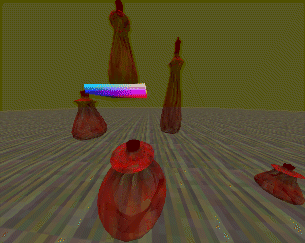EECS 590 Virtual Reality Tom DeFanti


EECS 590 Virtual Reality Tom DeFanti


Dream Grrrls, a virtual world created by Grit Sehmisch and Margaret Dolinsky, explores the immersive nature of dream imagery and the CAVE(TM), Cave Automatic Virtual Environment. The design focuses on, but is not limited to six factors for virtual reality aesthetics criteria outlined by Gigliotti:
Interface
Content
Environment
Perception
Performance
Plasticity.
The INTERFACE unites hardware, software and the user in a common space for action and reaction. Primary analysis evaluated the action in the CAVE (TM) based on application goals rather than on screen displays. The goal is to have a dynamic structure in which the user navigates with a variety of choices, experiences and interactions for enjoyment, exploration, decision-making and learning.
The CONTENT of such a virtual world is based on imagery and experiences similar to a dream-state. Fueled by the unconscious, interaction is often indulgent, whimsical, and self-reflective. Dream Grrrls introduces the user to the computer in an environment where he/she will confront imagery, tasks, kinesthetic sensations and expect the unexpected to meet new challenges.
The ENVIRONMENT or physical space will have familiar qualities in unfamiliar settings. For example, the user will navigate through a space to find brightly colored glass vessels and jars to explore. The most creative explorers will interact with these objects and find themselves thrown into newer and more challenging worlds. The user's role becomes very important in accepting the challenge to discover objects, paths, navigational strategies and the computer's responses.

PERCEPTION will guide the user as he/she can follow the line of sight (or not) through the stereoscopic headgear, experience a virtual sense of touch through a tracking wand that interacts with objects and a kinesthetic sense of movement through and around the space. The computer will provide "clues" with sight and hopefully, sound.
The PERFORMANCE will be based on the user's direct manipulation of the action and the quality of the subjective response. The following variables were considered as outlined in Brenda Laurel's book, Computer as Theatre:
In order to optimize the performance, visuals become portals to other scenes rather than presenting the world in its entirety. The program contains a set of multiple drawing functions that are executed depending on the viewers position. The visuals become critical to achieve a smooth and unified experience for the user.
The PLASTICITY of the piece is represented in its ability to give to the user - is it effective? Visual design is not to be underestimated, rather it is an indispensable aspect of this world, providing a representation of tasks for the user. The design materials influence structure, graphics, sound, tactile and kinesthetic effects to provide sensory, cognitive, and emotional input which shapes the user's action. Dream Grrrls will provide a virtual world of dreams to enhance learning, experience and communication.
References:
dolinsky@evl.eecs.uic.edu sehmisch@evl.eecs.uic.edu